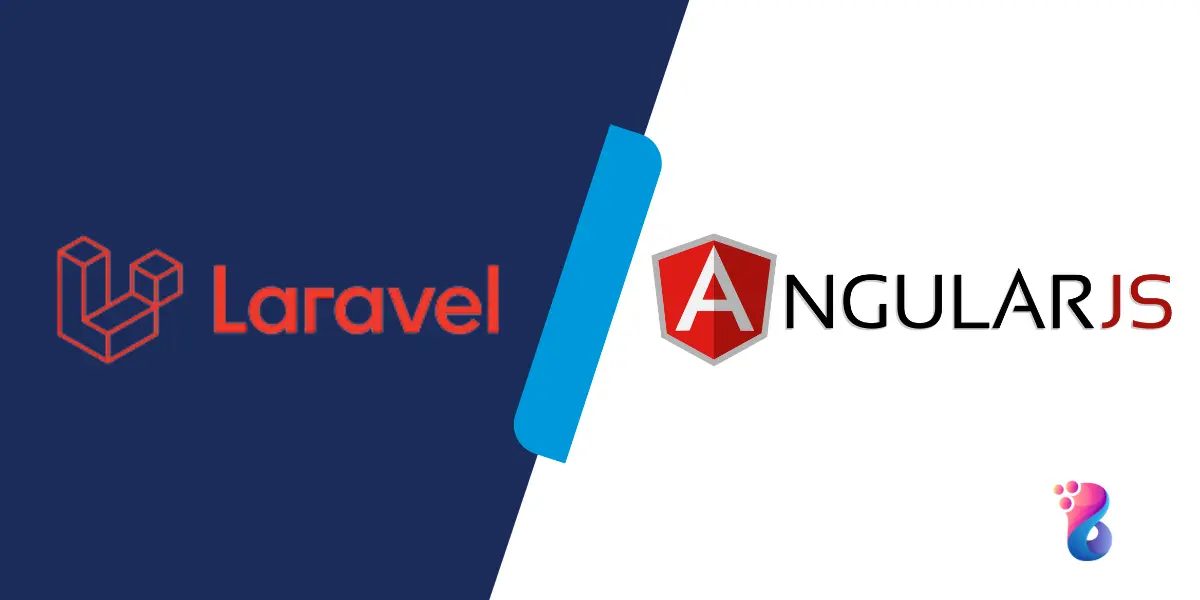
In an era where digital transformation reigns, web development has undeniably taken the center stage. With over 1.8 billion websites globally, the web development domain has seen significant growth and evolution. With this comes the need to choose the right tools to create robust, high-performing, and secure web applications. Two popular frameworks that developers grapple with today are AngularJS and Laravel.
AngularJS, a product of the tech giant Google, has been a game-changer in the front-end web development landscape since its launch in 2010. With an impressive market share of 0.5% among websites, its two-way data binding and dependency injection features make AngularJS a favorite among developers.
On the other hand, Laravel, a PHP framework, has gained immense popularity due to its elegant syntax and emphasis on web application security. According to a recent survey by Jetbrains, Laravel holds an impressive 10.5% share among PHP-based frameworks, with developers lauding its capabilities like the Eloquent ORM and Artisan CLI.
In this blog post, we take an in-depth look at AngularJS vs Laravel, examining their unique features, advantages, and the challenges they present. Furthermore, we will draw a comprehensive comparison between these two powerhouses of web development, aiming to provide you with key insights that can guide your decision-making process.
Stay with us as we navigate the world of web development, comparing two of its most influential frameworks. Your journey to informed decision-making starts here.
Understanding AngularJS

Introduction to AngularJS
Developed by Google, AngularJS emerged in 2010 as a powerful JavaScript-based open-source front-end web application framework. In essence, AngularJS simplifies the development and testing of single-page applications by providing a framework for model–view–controller (MVC) and model-view-viewmodel (MVVM) architectures. This robust tool allows you to extend HTML vocabulary, creating a readable, expressive, and quick-to-develop environment.
Key Features of AngularJS
Two-way data binding: One standout feature of AngularJS is its two-way data binding. It means that any changes in the user interface instantly influence the application objects and vice versa. This dynamic relationship allows for an immediate and automated synchronization between the model and the view.
Dependency injection: AngularJS brings the power of dependency injection to the front-end development. This design pattern allows for easier development and understanding of components. With AngularJS, you can neatly organize your code into reusable pieces, making it easier to manage, test, and maintain.
Directives: Directives form the backbone of AngularJS applications, allowing developers to invent new HTML syntax specific to their application. This feature elevates code readability, promoting easy comprehension of the application’s functionality. Directives bring about a level of dynamism and interactivity that was previously hard to achieve with traditional HTML.
Testing: AngularJS was built with testing in mind. It comes with an end-to-end unit testing setup. The dependency injection in AngularJS makes it easy to test by injecting mock data into your controller and measuring the output and behavior.
Advantages of AngularJS for Web Development
AngularJS has much to offer, from its ability to create single-page applications with a simple, yet sophisticated workflow, to its capacity to handle dependencies. Moreover, it supports MVC architecture, thereby making the coding process more comfortable and effective. The two-way data binding minimizes the server load, making AngularJS an efficient tool for web development.
Disadvantages and Challenges of AngularJS
Despite its many strengths, AngularJS is not without its challenges. Its complexity can be daunting to beginners. The framework operates differently from most other JavaScript frameworks, which might cause difficulties for those less experienced. Also, some developers find the two-way data binding feature to create performance issues on larger application projects.
Examples of Notable Projects Developed with AngularJS
Many high-profile web projects are powered by AngularJS. Some of these include video streaming app YouTube for PS3, weather site Weather.com, and e-commerce platforms like Freelancer and Upwork. These examples highlight the capabilities and strengths of AngularJS in managing high-traffic, complex web applications.
Understanding Laravel

Introduction to Laravel
Laravel, released in 2011 by Taylor Otwell, is a free, open-source PHP web framework. This comprehensive framework offers a clean and elegant syntax that aims to make web development tasks, such as routing, caching, and security, more accessible and intuitive for developers. With Laravel, the development process becomes a pleasing experience, rather than a daunting task.
Key Features of Laravel
MVC Architecture Support: Laravel supports the Model-View-Controller (MVC) architectural pattern, ensuring clarity between logic and presentation. This architecture aids in improved documentation, numerous built-in functions, and better performance.
Eloquent ORM: One of the standout features of Laravel is its implementation of the Eloquent ORM (Object-Relational Mapping). It simplifies the interaction with your database by providing an intuitive interface for querying and managing your databases. This results in cleaner, more readable code.
Security: When it comes to web application security, Laravel shines. It offers robust security features out of the box. These include hashed and salted passwords, protection against SQL injection attacks, and measures to prevent cross-site request forgery (CSRF).
Artisan CLI: Artisan, Laravel’s built-in command-line interface, offers a multitude of helpful commands for common tasks. From database migrations to publishing package assets, Artisan aids in automating repetitive and tedious programming tasks, thereby increasing development speed.
Advantages of Laravel for Web Development
Laravel’s strengths lie in its simplicity, robustness, and excellent documentation. It provides tools and libraries that streamline tasks, such as routing, security, and caching, making the process of web development smooth. Furthermore, Laravel’s community is large and active, providing a wealth of knowledge and resources for developers at all levels.
Disadvantages and Challenges of Laravel
However, Laravel also has its set of challenges. One common criticism is its relatively slow performance when compared to other frameworks. Also, Laravel may seem overwhelming for beginners due to its extensive set of features. Lastly, while Laravel’s Eloquent ORM is powerful, it can sometimes lead to efficiency issues with larger applications.
Examples of Notable Projects Developed with Laravel
Many well-known web applications have harnessed the power of Laravel. Examples include startups like Koel, a personal music streaming service, and Invoice Ninja, a popular invoicing platform for freelancers and businesses. Laravel’s contribution to these projects demonstrates its capacity to handle diverse applications with different needs and complexities.
Direct Comparison: AngularJS vs Laravel
Comparison of Architectural Patterns: While both AngularJS and Laravel adopt MVC architecture, their application varies. AngularJS, being a JavaScript framework, implements it on the client-side, creating dynamic and interactive web applications. Laravel, as a server-side PHP framework, employs MVC on the server-side, making server responses more efficient and streamlined.
Performance Comparison: Performance-wise, Laravel often gets flagged for its slower speed compared to other frameworks. However, it’s essential to consider that Laravel comes bundled with numerous features out of the box, which can impact its speed. AngularJS, on the other hand, provides a smooth and fast user experience due to its client-side execution. However, AngularJS’s two-way data binding can sometimes lead to performance bottlenecks with larger applications.
Comparison of Ecosystems and Community Support: Both AngularJS and Laravel boast active and large communities, making finding help or resources easier for developers. Laravel, as a part of the PHP ecosystem, benefits from the wide array of PHP libraries and tools. AngularJS, backed by Google, has an extensive ecosystem that includes various tools, comprehensive documentation, and community support.
Scalability and Ease of Use: AngularJS stands out in creating single-page applications and offers excellent scalability due to its intuitive modular design. Laravel, with its elegant syntax and built-in functionalities, provides an easy-to-use platform for developers. However, it requires a fundamental understanding of core PHP, which could affect its learning curve.
Comparison of Security Features: Laravel offers a high level of security, including CSRF protection, hashed and salted passwords, and SQL injection protection. In contrast, AngularJS, while providing basic security features, leaves much of the security considerations to the server side. It’s crucial to note that security in web development should be a holistic consideration, not solely reliant on the chosen framework.
Learning Curve Comparison: AngularJS might present a steep learning curve due to its unique approach to JavaScript development, especially for beginners. Laravel, despite being feature-rich, has excellent documentation and an elegant syntax, which can simplify the learning process. But, basic familiarity with PHP is a prerequisite to get started.
Choosing the Right Framework: AngularJS vs Laravel
Selecting the right web development framework can feel like an uphill task, given the array of tools available in today’s digital world. When it comes to AngularJS and Laravel, both have established their credibility with unique features, supportive communities, and extensive use cases.
When to choose AngularJS for your project
Consider opting for AngularJS if your project involves creating dynamic, single-page applications. AngularJS’s two-way data binding, directives, and dependency injection provide a robust framework for such applications. If your team has a solid background in JavaScript and requires a framework that offers interactive user interfaces, AngularJS might just be your perfect fit.
When to choose Laravel for your project
If your project leans towards server-side scripting, Laravel could be your tool of choice. Its elegant syntax, extensive security features, and the convenience of Eloquent ORM make it ideal for complex backend functionalities. Laravel is particularly beneficial if your team is comfortable with PHP and seeks a framework that can offer a structured and secure approach to web application development.
Key considerations for choosing between AngularJS and Laravel
When deliberating between AngularJS and Laravel, several factors come into play. Consider your team’s expertise and the nature of the project. Is the application client-focused, or does it require extensive server-side operations? Assess the scalability needs of your project, keeping future growth in mind. Lastly, evaluate the community support and learning resources available for each framework, as these can significantly influence your team’s productivity and the application’s long-term maintenance.
Remember, the choice between AngularJS and Laravel isn’t a matter of which framework is better. Instead, it’s about which framework better suits the needs of your specific project. Understanding this can guide you in making an informed, purpose-driven choice in your web development journey.
Conclusion
So, what’s your pick: AngularJS or Laravel? Or do you believe a blend of both might pave the way for your next successful web development project? Share your thoughts, experiences, or even your hesitations with us. Let’s keep this conversation going.
Your feedback not only enriches this discussion but also aids other readers in their journey towards choosing the right framework. We look forward to hearing your unique insights and exploring these powerful web development tools further with you. Let’s learn and grow together in this ever-evolving world of web development!